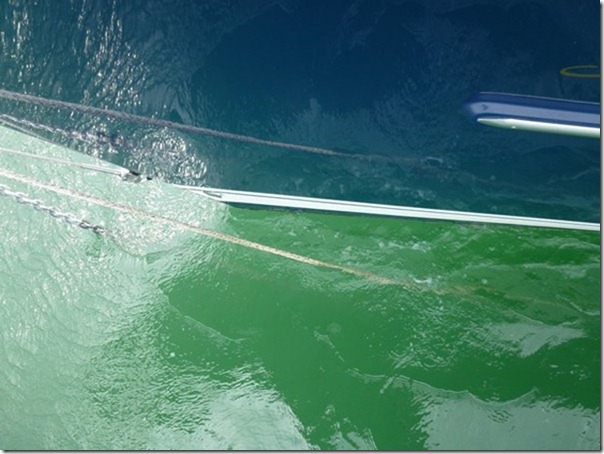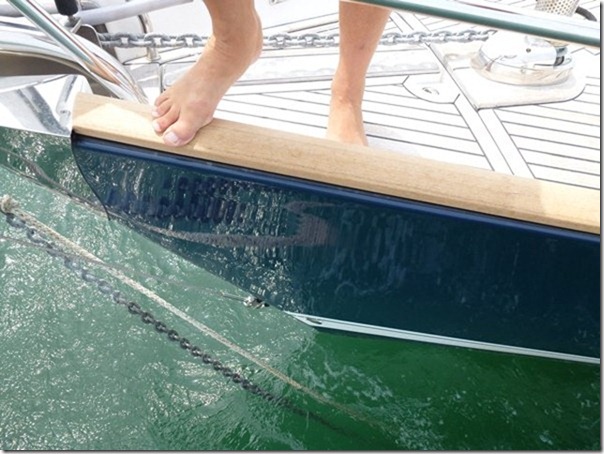Suzie Too's Anchoring Tips

Suzie Too - Western Caribbean
David & Suzanne Chappell
Tue 12 Jul 2011 18:59
|
Girls skip to the next chapter, and read about nice fluffy things,
relationships, feelings and missing people (no, no one is lost you know what I
mean – girlie stuff).
Wherever we travel in the world all the Brits seem to be following the RYA
Mantra regarding the amount of chain to be used when anchoring, often I hear 3 x
depth for chain and 4 x depth for rope (who on earth sleeps with their boat tied
to the seabed with a bit of string!).
I have just checked on the RYA and its seems below may be the current
calculation, but it’s still not enough in many instances and as a result we have
had several of our English cruising friends come to grief using this ratio. For
a lunchtime stop in a crowded anchorage, obviously all scope should be similar
and if you are not leaving the boat it may well be OK. I would say anchor away
from everyone else, put out plenty of chain and enjoy your lunchtime power nap
and if you decide to stay the night, you have already been anchored for 8 hours
and can be relatively assured all should be well.
From the RYA
Website
How much rope and
chain needs to be put out?
Scope of Chain
The Yachtmaster Instructors I sailed from the Iles de Glenan Sailing School
with on the RIDS use a better ratio – never less than 2 x your boat length plus
1 1/2 x the depth.
Yes, I know the French don’t always follow this, but often they use a Brake
anchor which does just that, guaranteed to break out in the middle of the
night.
So if I were to anchor in 5m of water under the RYA I would put out 20m –
NEVER and Elsie wouldn’t sleep – there will be no scope on the seabed and every
chance in such shallow water that on the turn of the tide we could catch our
keel. We have swum over our anchor, a 40kg Delta, in the Caribbean in 10m water
with 50m of chain in 15kts of wind and you would be horrified at how little
scope there is left on the seabed.
Under the French Guideline in 5m I would put out 2 x boat @ 18m plus 1.5 x
depth 7.5m = about 45m – Yes, plus extra is now going out on the snubbing
line.
But to be honest we would never anchor in such shallow water. We usually
look for a 6-10m depth because if the sea cuts up rough with a 2m wave and swell
combination in 5m you have a 40% change in the water height. Suzie Too, in 10m
well we only get a 20% change in water height.
PS If you do get your chain around your keel – walk a rope
back down both sides of the boat (get a friend to take the other end) giving it
time to sink and pull gently backwards when you get to the stern quarters. If
you have a torpedo shaped fin on the bottom of your keel then I suggest you
enrol your wife on a PADI dive course as she probably can’t hold her breath long
enough to snorkel down and unhook it.
Snubbing Line
A snubbing line is meant to do just what is says, most Brits and others
seem to have about 2-3m of line which only stops the anchor chain graunching on
the stemhead, it gives your chain, anchor holding and deck fittings no
protection.
Again my French friends say they should be not less than 8m – this gives
1-2m to the stemhead, 2m to the water and allows 4-5m for current and wind –
look at the photo below – if you anchor in wind against tide you will have the
chain all the way down the side of your hull. Here we are in Nantucket Harbor
(local spelling) in a 3kt Spring Ebb and a 30kt wind (but still in
shorts!)
We secure our snubbing line on the deck by taking a full turn around the
anchor capstan and then taking the eye splice back to a bow cleat. This keeps
the load straight through the stemhead, shares the load between the 2 fittings
and means we can pull the turns off the capstan, quickly loose the splice and
throw the whole thing overboard while retrieving our anchor if we have to move
in a hurry, cos someone's dragging theirs and heading for you.
Most times though with 50m of scope you have enough room to drive around
the anchor to miss them and that we have had to do on several occasions. Another
good reason to anchor away from the crowd and have lots of scope, you just have
a longer dinghy ride.
Once you have the snubbing line in place let out at least another 3m
otherwise in this photo the chain would be against our hull, as it is it is just
the force of the current pushing the scope towards the boat. Our snubbing line
is 25mm octoplait with a 2m length of clear plastic pipe to prevent chaffing in
the stemhead.
Anchor Alarm
The other thing we always do is set our anchor alarm. We have a separate
Furuno GP-33 that uses very little power and set it as soon as we drop the
anchor so that it is at the centre of our anchor circle. As we mostly seem to
anchor with 45m of chain and about 7m of snubbing line we set the anchor alarm
on 0.06NM.
OK Here is the calculation a Nautical Mile is 1,850 metres, so then 0.01 is
18,5m, as my scope is 50 metres the total distance from one side of the circle
to the other is 100m – therefore 6 x 18,5m is about 100 metres and allows us to
swing on the tide without alarming.
Finally it is located in our AFT CABIN right next to the bed, it is very
reassuring when you turn over at night to look at the track it has plotted,
often a doughnut shape and if you hear the wind get up you can see the display
says 0.04Nm and go back to sleep. Yes it costs about £300, but if you spend 10
night less in a marina this year – its FREE, after that you are squids in – well
more beer money anyway.
Happy anchoring
From the Bridge of the Exceptionally Good Ship “Suzie Too”
   |